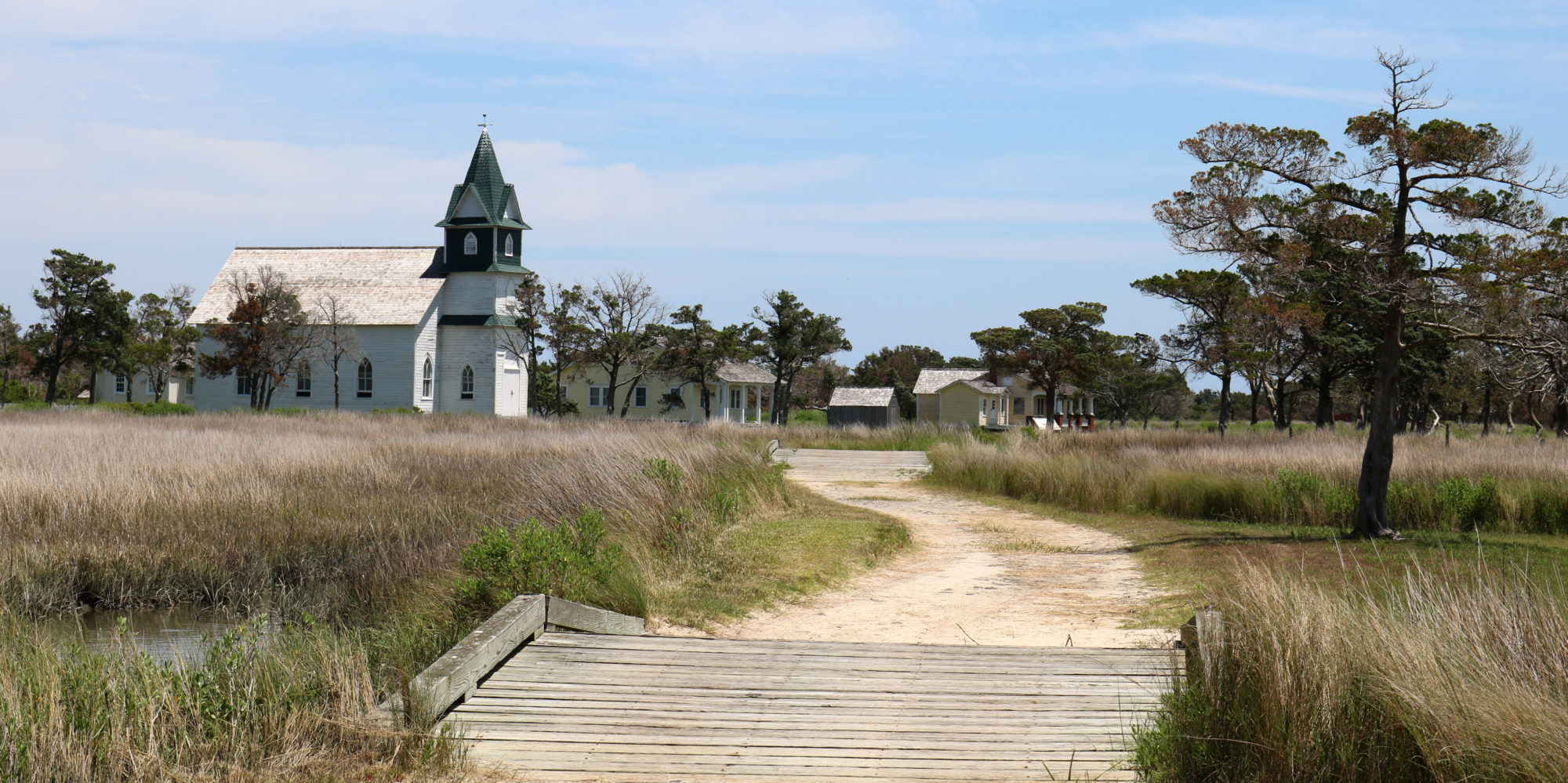Life here is different nowadays. Missing are the herds of roaming livestock that preserved the village’s low, windswept appearance. Gone is the bustling waterfront of Portsmouth’s heyday: the boat captains, fishermen, U.S. LIfe-Saving Station staff, and storekeepers. Established in 1753 by an act of the North Carolina Assembly, Portsmouth grew to be the largest settlement on the Outer Banks by 1770. For nearly a century, the town remained a major shipping center. Ocracoke Inlet was the major trade route through the Outer Banks to important North Carolina ports. However, large, heavily laden ships found the inlet too shallow to sail through and were forced to transfer their cargo to lighter, shallow draft boats. Portsmouth was established to provide storage and support facilities for this business. As the shipping industry grew, Portsmouth thrived. In 1842, over 1400 vessels and two thirds of North Carolina’s exports passed through Ocracoke Inlet. In 1860 the population of Portsmouth grew to 685 residents. The coming of the Civil War signaled the end of an era for the village. Many residents fled for the mainland as the Union Army marched down the Outer Banks. A large portion did not return after the war. Their reasons were economical as well as political. Even before the war began, Ocracoke Inlet had begun to shoal, (shallow), and a new, deeper inlet was opened at Hatteras by a ferocious storm in 1846. Shipping routes shifted north. In addition, more and more goods began traveling on inland railroads.
A Fishing Hamlet
Portsmouth´s days as a center of commerce were over. Fishing replaced shipping as the primary occupation for the islanders that remained. In 1894, the U.S. Life-Saving Service was established on Portsmouth and for nearly 50 years played a vital role in the community. Steadily the population declined. In 1956 only 17 residents remained. The walls of time closed in on Portsmouth. Isolation, a depressed economy, and the constant threat to life and property from storms prompted the final abandonment of Portsmouth . With the death of Henry Pigott in 1971, Portsmouth´s last two residents, Marion Babb and Elma Dixon, reluctantly moved to the mainland. Another chapter in Portsmouth´s history had come to an end.
A Quiet Historic Village
In 1976 with the establishment of Cape Lookout National Seashore, new life came to Portsmouth. The 250-acre historic district of Portsmouth is listed on the National Register of Historic Places, an honor roll that recognizes outstanding historic buildings and districts throughout the United States. As one walks the lanes and trails of Portsmouth´s lost lifestyle, the buildings display a close knitted community which was typical along the Outer Banks. The modest houses speak of a working class community.
The People
Buildings alone cannot tell the Portsmouth story. Its history is not so much of ships, wharves, and fishing, but of the people who once lived there. Portsmouth is Miss Mary Dixon, a teacher in the island´s one room schoolhouse. For 37 years Miss Dixon taught readin´, ´ritin´, and ´rithmatic to all the island´s youth. Portsmouth is Sam Tolson. A waterman by trade, “Uncle Sam” and his “dancin´ slippers” highlighted many a Portsmouth social event. “Uncle Sam”, it was said, could balance a glass of water on his head and dance for hours without spilling a drop. Portsmouth is all the proud individuals who have called this seafaring village home.
Glimpses of Portsmouth
The United States Life-Saving Service Station was a leading influence in the community from the turn of the century until its decommission in 1937. Often the local people made up the crew members. Life was disciplined, drills harsh, and respect in the community widespread. The first appointed keeper was F.G. Terrel. From the watchtower, a nightly guard scanned the seas for vessels in trouble. Patrols walked the beach. Behind the large doors of the boathouse, oar powered surf rescue boats waited; ready to be rushed down the ramp and out to sea at a moment´s notice. While the Life-Saving Service played an important role for the islanders, the church filled another niche in their lives. The “Bankers” existence was at the mercy of the sea; their faith was placed in God for guidance. At one time the island had two churches, a Methodist and a Primitive Baptist. Both churches were destroyed in a 1913 storm. The Methodist church was rebuilt the following year and it still stands today. In the center of Portsmouth stands the town´s information and social hub, the United States Post Office, established in 1840. As far back as memory goes, the Post Office also served as a general store. Political discussions, fish tales, and croquet matches were typical afternoon affairs outside this structure. As Portsmouth declined, the Post Office remained one of the village´s few links with the outside world. In 1956 a postage stamp was the town´s only purchasable commodity. In 1959, the Post Office closed its doors for the last time. Summer kitchens and dairy houses provide views of an earlier time without generators or electricity. The kerosene stoves of the past could leave houses sweltering in the summer. Thus cooking was restricted to separate kitchen buildings. With no refrigerators on the island, residents used a shaded-screened dairy house and a cooling sea breeze to keep perishable items fresh.
